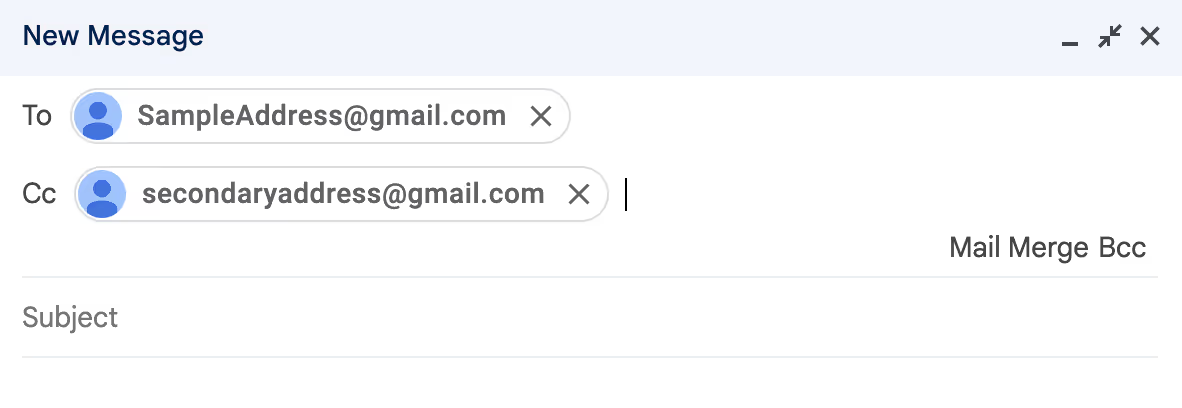How to schedule an email in Gmail
Learn 3 ways to schedule emails in Gmail so you can send messages later and reach your recipients at the right time.
When you send an email to multiple people, you don’t have to make them all primary recipients. Sending a carbon copy (CC) or blind carbon copy (BCC) may be the better option for including additional people in the conversation, depending on the situation.
So what does it mean to CC or BCC someone, and when is the best time to use these features instead of emailing the recipient directly? Understanding when and how to use different email options will help you step up your business communications.
Let’s break down everything you need to know about using CC and BCC in Gmail – we’ll also show you another way you can share read-only copies of your emails with anybody.
<a href="#options-for-adding-email-recipients" class="anchor-link">Options for adding email recipients</a>
<a href="#how-to-cc-in-gmail" class="anchor-link">How to CC in Gmail</a>
<a href="#how-to-use-bcc-in-gmail" class="anchor-link">How to use BCC in Gmail</a>
<a href="#how-to-use-streak-share" class="anchor-link">How to use Streak Share</a>
<a href="#how-to-use-streak-mail-merge" class="anchor-link">How to use Streak mail merge</a>
<div class="anchor-wrapper"><div id="options-for-adding-email-recipients" class="anchor-target"></div></div>
When you start drafting a new email, there are three fields where you can add recipients:
People added to any of these three fields will receive the email in their inbox, so, on the surface, the end result is the same regardless of which option you choose. If you dig a little deeper, each field does something slightly different.
With the Streak extension installed, you have two additional options for sharing emails. Use the Streak share feature to create a view-only link for your email thread that you can paste anywhere. People not directly involved in the conversation can view the whole thread (including later updates) through this link.
Alternatively, create a mail merge with Streak to send personalized mass emails to your contacts. There’s no need to add recipients individually — pull contacts directly from your Streak pipelines or upload contacts from a spreadsheet to save time.
<div class="anchor-wrapper"><div id="how-to-cc-in-gmail" class="anchor-target"></div></div>
The CC feature allows you to send your emails to people other than the primary recipients. The people you CC receive the same email as the primary recipients — the only difference is that their email addresses appear in the CC field, not the “To” field.
This small distinction tells CC recipients that they (typically) don’t need to take any action on the email; the sender is just keeping them in the loop. That’s why they’re secondary recipients.
Follow these steps on how to CC in Gmail:

Keep in mind that anyone who receives the email — whether they’re a primary recipient or CC’d on the message — can view all the other recipients’ email addresses.
<div class="anchor-wrapper"><div id="when-to-use-cc" class="anchor-target"></div></div>
There are many different situations when using the CC feature is helpful. A few common examples include:
As useful as the CC feature can be, it has flaws. Overusing the CC feature leads to cluttered inboxes and frustration as people get bombarded with emails that aren’t relevant to them. Everyone can also see everyone else’s contact information which may be a privacy concern, depending on the recipients and the content of the message.
<div class="anchor-wrapper"><div id="how-to-use-bcc-in-gmail" class="anchor-target"></div></div>
Using BCC — blind carbon copy — instead of CC covers many of these privacy concerns. The BCC function is just like the CC function, except that BCC’d recipients are hidden from the other message recipients. Additionally, somebody who receives a BCC’d email can’t see who the primary recipients or any CC’d recipients are.
If you send an email with a primary recipient, one CC’d recipient, and three BCC’d recipients, the primary and CC’d recipients won’t know there are any BCC’d recipients. Even the BCC’d contacts won’t see the others who received a blind copy. BCC’d contacts are only visible to you, the sender.
To BCC someone, follow steps similar to how to CC in Gmail:
<div class="anchor-wrapper"><div id="when-to-use-bcc" class="anchor-target"></div></div>
Some situations when the BCC feature is useful include:
The main drawback of using BCC over other sending options is that it may look underhanded or shady. If BCC’d recipients “reply all” to an email with other primary or CC’d recipients, they expose their contact information to the other recipients.
<div class="anchor-wrapper"><div id="how-to-use-streak-share" class="anchor-target"></div></div>
CC and BCC aren’t your only options for sharing emails. Streak Share lets you create a shareable view-only link to any email in your inbox that you can copy and paste anywhere.
Streak Share links always show a real-time version of the email thread, including responses sent after you create and share the link. If you don’t want people to see the email thread anymore, revoke access at any time by toggling off sharing with one click.
Create your unique Streak Share link with these steps:

Paste this link wherever you’re collaborating — email, Google doc, text message, Slack, etc. — to bring other people up-to-date on your email conversation.
Streak Share is ideal for sharing your email threads, but remember that the link is view-only. The people you share the link with cannot participate in the conversation.
<div class="anchor-wrapper"><div id="how-to-use-streak-mail-merge" class="anchor-target"></div></div>
Streak mail merge is a tool that lets you send personalized mass emails with automatic follow-up sequences.

Instead of typing long contact lists in the “To,” CC, or BCC fields, select boxes from your Streak pipelines or upload contacts from a spreadsheet to add recipients to the message.
Each recipient will receive a personalized message that looks like it’s only to them. They won’t see any other recipients of the message.
Here’s how to create your own mail merge:
Streak Mail Merge is ideal for sending personalized emails to long contacts lists. This feature is especially useful in situations like:
